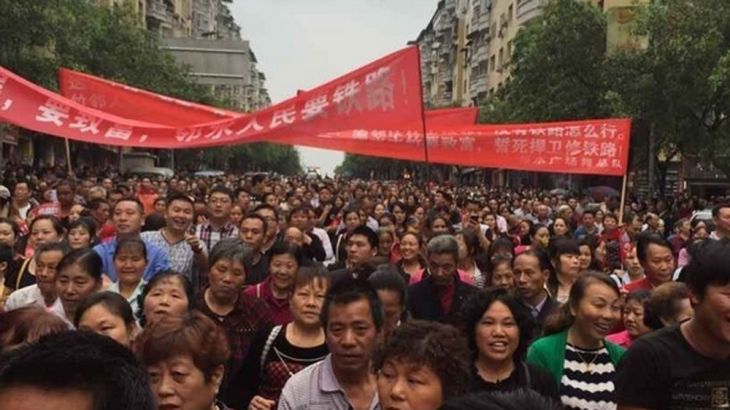How a violent protest unfolded in China
Al Jazeera news crew assaulted by SWAT team and held for several hours while reporting on a confrontation in Sichuan.

Linshui has the feel of a town that’s still waiting for better economic times.
Many of its mildew-speckled buildings weep with neglect.
At the entrance to the town a giant banner is attached to the wall.
It bears the face of this area’s most famous son, Deng Xiaoping, the architect of economic reforms that helped pull millions out of poverty.
A proposed high-speed rail link was also supposed to help deliver that to this remote town of more than a million people.
But when the Sichuan provincial government appeared to change its mind, instead diverting the rail link to Guangan city, the hometown of Deng, tens of thousands of Linshui’s people rose up.
And they did so with the blessing of local leaders.
How a peaceful protest that began on Saturday morning ended in a violent confrontation between police and demonstrators is still unclear.
Scale of unrest
Pictures circulating on social media, though, appear to bear testimony to the scale of the unrest.
None of these images can be independently verified.
One shows a young boy in school uniform lying in a pool of blood.
Other young victims are also shown nursing wounds.
There seems to be blood in every image.
In the local hospital some of the injured accused the police of using excessive force.
You could clearly hear the safety catches on their weapons being switched off.
None was critical of the government or party.
On Monday there was a heavy police presence close to the scene of some of the fiercest unrest.
Tinny loud speaker announcements echoed around the streets warning people “not to spread rumours and to maintain social stability”.
Torn banners hung from half-finished buildings beside the road that connects Linshui to a nearby expressway that protesters managed to block on Saturday and Sunday.
The expressway links Linshui to the provincial capital, Chongqing.
The entrance to the expressway is now guarded by police.
Protests in China are no longer the rarity they once were.
They are permitted, as long as they don’t demand the downfall of the Communist Party.
The protests are mostly over single issues: the environment, corruption or a demand to be connected to China’s high speed rail network.
The provincial government in Sichuan says it’s yet to make a final ruling on whether that will happen in the case of Linshui.
According to figures from foreign human rights and labour groups, there were more than 20,000 protests in China last year.
Few demonstrations, however, in recent times have been on the scale of the weekend unrest in Linshui.
Assault rifles and shotguns
The local government had allowed Al Jazeera to report on the town’s return to normality. But that didn’t quite work out.
As I was recording a statement to camera in the street, watched by our official minders, a 4×4 vehicle with tinted windows suddenly screeched to a halt beside us.
Four men dressed in black battle fatigues and armed with assault rifles and shotguns came running towards us, shouting orders in Mandarin to lie on the ground.
We were all too stunned to move.
https://twitter.com/ajabrown/status/600220814185607170
You could clearly hear the safety catches on their weapons being switched off. One member of the SWAT team tried to force Ling Pei, an Al Jazeera English producer, to lie face down.
Paul Sutton, our cameraman, was struck between the shoulder blades as his camera and tripod were snatched from him.
The commandos left as quickly as they arrived. But we were later held for several hours.
All this happened in front of our government minders who were also jostled and shouted at.
A case, perhaps, of overlapping authority.
The camera was eventually returned but all the material on the memory cards had been wiped clean.
The authorities are literally trying to erase evidence of what happened.